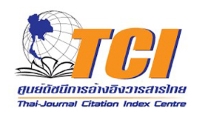JOURNAL DETAIL
Dry Sliding Wear Behavior of Sintered SS316L-Sn Containing MoS2 Solid Lubricant
Paper Type |
Contributed Paper |
Title |
Dry Sliding Wear Behavior of Sintered SS316L-Sn Containing MoS2 Solid Lubricant |
Author |
Wantana Koetniyom, Yossawas Nopjinda, Romechalee Tepnok, Nattaya Tosangthum, Monnapas Morakotjinda, Thanyaporn Yotkaew, Pongsak Wila and Ruangdaj Tongsri* |
Email |
ruangdt@mtec.or.th |
|
Abstract: Traditional powder metallurgical process is commonly used for producing self-lubricating
composites. Solid lubricant dispersion in the steel matrices affects tribological properties by lowering
friction coefficient leading to lifetime extension of steel matrix composite parts. Molybdenum disulfide
(MoS2) is one of the most used solid lubricants since its lamellar crystalline structure can form a
sliding film adhering to the rubbing surfaces. The sliding film acts as anti-friction or anti-wear layer.
Due to such action, MoS2 is widely used for providing friction reduction in a situation where the use
of liquid lubricants is impractical. However, MoS2 decomposes and reacts with the matrix at high
temperatures, usually employed for producing sintered self-lubricating composites. The reaction leads
to undesirable products when the powder metallurgical route is used to incorporate MoS2 into steel
matrices. In order to lessen undesirable reaction, the temperature-activated phenomenon, resulting in
decrease of lubricating efficiency, it is necessary to find the method for mitigating decomposition and
reaction. In this work, tin (Sn) powder was added to the mixtures of 316L stainless steel and MoS2
powders with expectation that sintering enhancement by Sn powder addition would reduce sintering
temperatures and thus reduce MoS2 + 316L reaction. Varied MoS2 contents (5, 10 and 15 wt. %) were
mixed with fixed 4 wt. % Sn and balance 316L stainless steel powder. The green compacts of powder
mixtures were sintered at temperatures of 1,150 ºC and 1,200 ºC in hydrogen atmosphere for 45 min.
Mechanical properties and dry-sliding wear behavior of the sintered composites were investigated.
Liquid phase sintering due to Sn powder addition was observed. However, the energy dispersive
spectroscopy (element mapping mode) showed that the reaction between MoS2 and alloying elements
in 316L powder occurred and resulted in sulfide formation. It was found that the amount of added
MoS2 had influences on the tensile properties, hardness and sintered density. Although wear resistance
and friction coefficient slightly increased according to the MoS2 content, the added MoS2 amounts
higher than 10 wt.% led to adverse effect. |
|
Start & End Page |
838 - 853 |
Received Date |
2019-07-25 |
Revised Date |
|
Accepted Date |
2020-02-10 |
Full Text |
Download |
Keyword |
powder metallurgy, solid lubricants, molybdenum disulfide, friction coefficient |
Volume |
Vol.47 No.4 (Special Issue II : July 2020) |
DOI |
|
Citation |
Koetniyom W.,Nopjinda Y.,Tepnok R.,Tosangthum N.,Morakotjinda M.,Yotkaew T., et al., Dry Sliding Wear Behavior of Sintered SS316L-Sn Containing MoS2 Solid Lubricant, Chiang Mai Journal of Science, 2020; 47(4): 838-853. |
| View:1,381 Download:4,382 | |
RELATED ARTICLE
Fundamental Compacting and Sintering of Stainless
Steel 409L Powders
page: 23 - 30
Author:Ornmanee Coovattanachai* [a], Bhanu Vetayanugul [a], Rungtip Krataitong [a], Prayoon Lasutta [a],
Vol.32 No.1 (JANUARY 2005) View: 918 Download:257
page: 23 - 30
Author:Ornmanee Coovattanachai* [a], Bhanu Vetayanugul [a], Rungtip Krataitong [a], Prayoon Lasutta [a],
Vol.32 No.1 (JANUARY 2005) View: 918 Download:257
On the Production of Aluminium Foams Stabilised
Using Particles of Rice Husk Ash
page: 302 - 311
Author:Seksak Asavavisithchai, and Rath Tantisiriphaiboon
Vol.36 No.3 (SEPTEMBER 2009) View: 866 Download:243
page: 302 - 311
Author:Seksak Asavavisithchai, and Rath Tantisiriphaiboon
Vol.36 No.3 (SEPTEMBER 2009) View: 866 Download:243
Fabrication of Open-Cell Silver Foams Using Disaccharide as Space Holders
page: 222 - 230
Author:Seksak Asavavisithchai, and Ekasit Nisaratanaporn
Vol.37 No.2 (MAY 2010) View: 855 Download:253
page: 222 - 230
Author:Seksak Asavavisithchai, and Ekasit Nisaratanaporn
Vol.37 No.2 (MAY 2010) View: 855 Download:253
Effect of TiC Particles on Foamability and Compressive Properties of Aluminium Foams
page: 213 - 221
Author:Seksak Asavavisithchai, and Apiyut Opa
Vol.37 No.2 (MAY 2010) View: 885 Download:233
page: 213 - 221
Author:Seksak Asavavisithchai, and Apiyut Opa
Vol.37 No.2 (MAY 2010) View: 885 Download:233
Copyrights © Since 2021 All Rights Reserved by Chiang Mai Journal of Science










